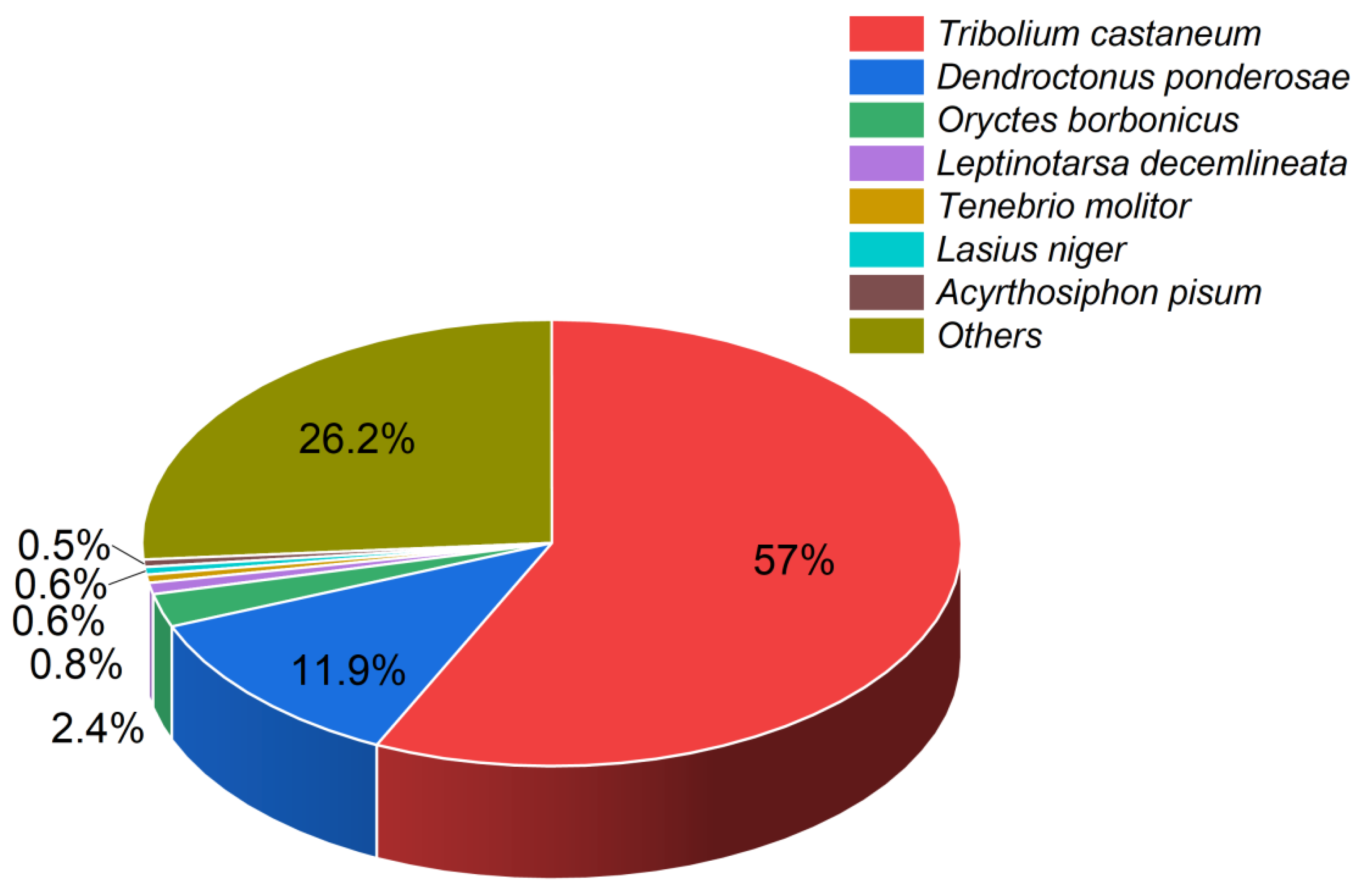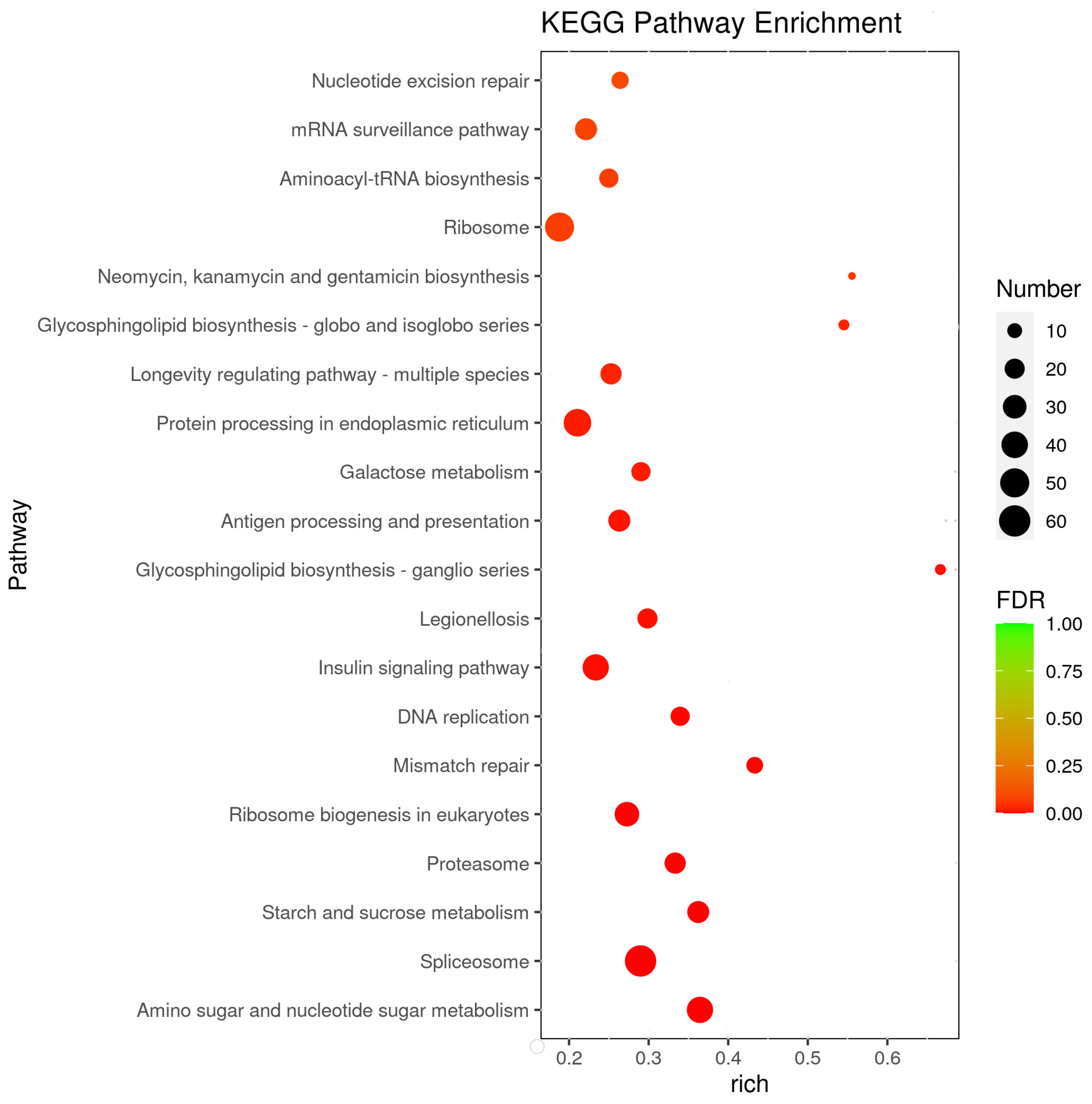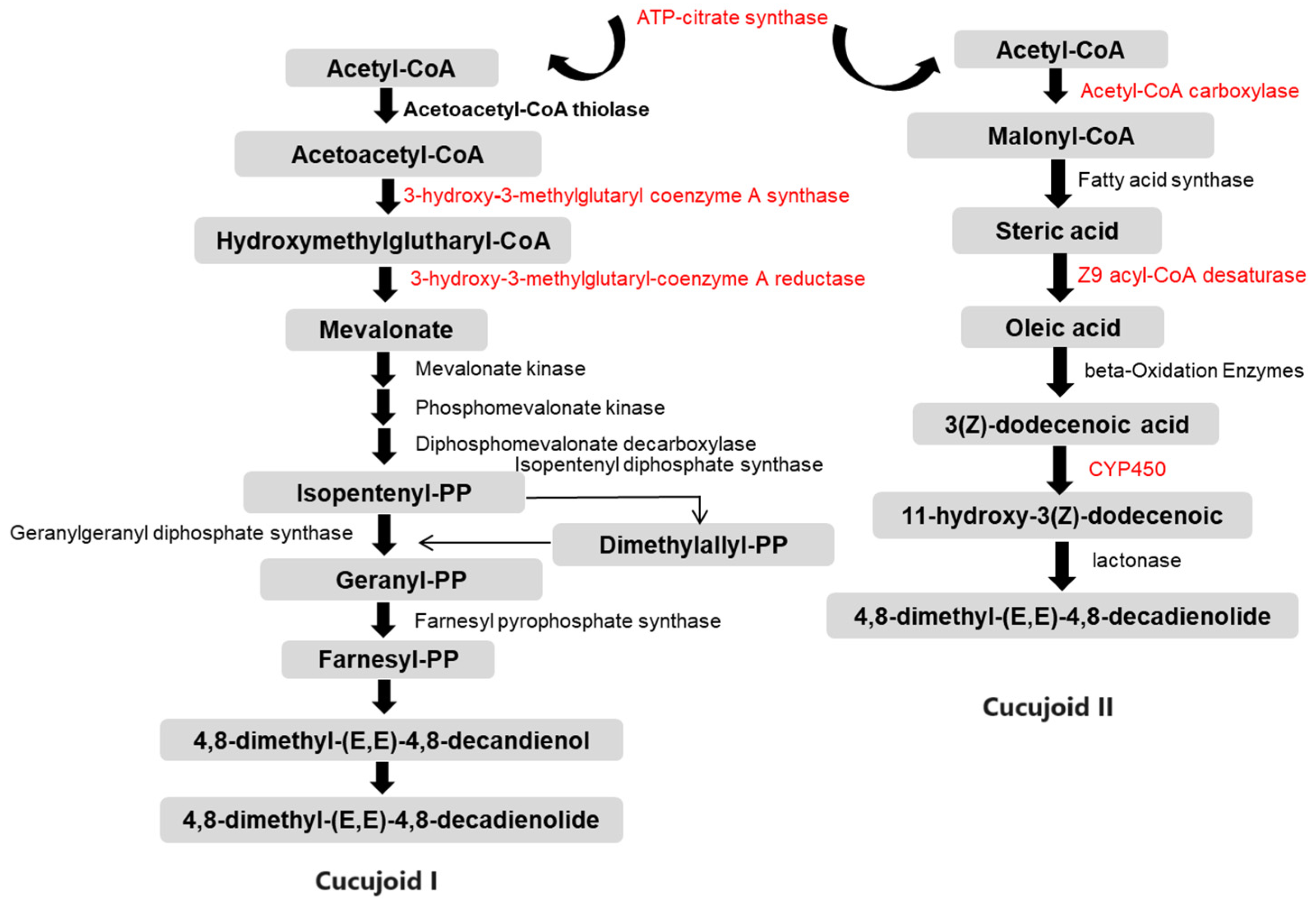Comparative Transcriptomics Analysis Reveals Rusty Grain Beetle’s Aggregation Pheromone Biosynthesis Mechanism in Response to Starvation
Abstract
:Simple Summary
Abstract
1. Introduction
2. Experiment and Methods
2.1. Insect Rearing and Sample Preparation
2.2. cDNA Library Construction and Sequencing
2.3. RNA-Seq Analysis
2.4. Validation of Gene Expression Levels
2.5. Data Analysis
3. Results
3.1. Summary of Transcriptome-Sequencing Data
3.2. Functional Annotation
3.3. RNA-Seq Analysis
3.4. Differentially Expressed Genes in Putative Pheromone Biosynthesis Pathway
3.5. Validation of the Key Genes in the FAS and MVA Pathways
4. Discussion
5. Conclusions
Supplementary Materials
Author Contributions
Funding
Data Availability Statement
Acknowledgments
Conflicts of Interest
References
- Baitharu, I.; Shroff, S.; Sahu, J.K. Molecular, Neuronal, and Behavioral Mechanism of Communication Among Insect Species: A Review. In Trends in Insect Molecular Biology and Biotechnology; Kumar, D., Gong, C., Eds.; Springer: Cham, Switzerland, 2018. [Google Scholar]
- Žunič Kosi, A.; Zou, Y.; Hoskovec, M.; Vrezec, A.; Stritih, N.; Millar, J.G. Novel, male-produced aggregation pheromone of the cerambycid beetle Rosalia alpina, a priority species of European conservation concern. PLoS ONE 2017, 12, e0183279. [Google Scholar] [CrossRef] [PubMed]
- Niassy, S.; Tamiru, A.; Hamilton, J.G.C.; Kirk, W.D.J.; Mumm, R.; Sims, C.; de Kogel, W.J.; Ekesi, S.; Maniania, N.K.; Bandi, K.; et al. Characterization of Male-Produced Aggregation Pheromone of the Bean Flower Thrips Megalurothrips sjostedti (Thysanoptera: Thripidae). J. Chem. Ecol. 2019, 45, 348–355. [Google Scholar] [CrossRef]
- Isitt, R.L.; Bleiker, K.P.; Pureswaran, D.S.; Hillier, N.K.; Huber, D.P.W. The Effect of Feeding and Mate Presence on the Pheromone Production of the Spruce Beetle (Coleoptera: Curculionidae). Environ. Entomol. 2018, 47, 1293–1299. [Google Scholar] [CrossRef]
- Blomquist, G.J.; Figueroa-Teran, R.; Aw, M.; Song, M.; Gorzalski, A.; Abbott, N.L.; Chang, E.; Tittiger, C. Pheromone production in bark beetles. Insect Biochem. Mol. Biol. 2010, 40, 699–712. [Google Scholar] [CrossRef]
- Vanderwel, D.; Johnston, B.; Oehlschlager, A. Cucujolide biosynthesis in the merchant and rusty grain beetles. Insect Biochem. Mol. Biol. 1992, 22, 875–883. [Google Scholar] [CrossRef]
- Tillman, J.A.; Seybold, S.J.; Jurenka, R.A.; Blomquist, G.J. Insect pheromones—An overview of biosynthesis and endocrine regulation. Insect Biochem. Mol. Biol. 1999, 29, 481–514. [Google Scholar] [CrossRef]
- Du, M.; Liu, X.; Ma, N.; Liu, X.; Wei, J.; Yin, X.; Zhou, S.; Rafaeli, A.; Song, Q.; An, S. Calcineurin-mediated Dephosphorylation of Acetyl-coA Carboxylase is Required for Pheromone Biosynthesis Activating Neuropeptide (PBAN)-induced Sex Pheromone Biosynthesis in Helicoverpa armigera. Mol. Cell. Proteom. 2017, 16, 2138–2152. [Google Scholar] [CrossRef]
- Seybold, S.J.; Vanderwel, D. Biosynthesis and endocrine regulation of pheromone production in the Coleoptera. Insect Pheromone Biochem. Mol. Biol. 2007, 6, 137–200. [Google Scholar]
- Martinez, B.A.; Gill, M.S. The SR protein RSP-2 influences expression of the truncated insulin receptor DAF-2B in Caenorhabditis elegans. G3 (Bethesda) 2023, 13, jkad064. [Google Scholar] [CrossRef]
- Palouzier-Paulignan, B.; Lacroix, M.C.; Aimé, P.; Baly, C.; Caillol, M.; Congar, P.; Julliard, A.K.; Tucker, K.; Fadool, D.A. Olfaction under metabolic influences. Chem. Senses 2012, 37, 769–797. [Google Scholar] [CrossRef]
- Saveer, A.M.; Kromann, S.H.; Birgersson, G.; Bengtsson, M.; Lindblom, T.; Balkenius, A.; Hansson, B.S.; Witzgall, P.; Becher, P.G.; Ignell, R. Floral to green: Mating switches moth olfactory coding and preference. Proc. Biol. Sci. 2012, 279, 2314–2322. [Google Scholar] [CrossRef]
- Schneider, J.E.; Wise, J.D.; Benton, N.A.; Brozek, J.M.; Keen-Rhinehart, E. When do we eat? Ingestive behavior, survival, and reproductive success. Horm. Behav. 2013, 64, 702–728. [Google Scholar] [CrossRef]
- Ryan, D.A.; Miller, R.M.; Lee, K.; Neal, S.J.; Fagan, K.A.; Sengupta, P.; Portman, D.S. Sex, age, and hunger regulate behavioral prioritization through dynamic modulation of chemoreceptor expression. Curr. Biol. 2014, 24, 2509–2517. [Google Scholar] [CrossRef]
- LeDue, E.E.; Mann, K.; Koch, E.; Chu, B.; Dakin, R.; Gordon, M.D. Starvation-Induced Depotentiation of Bitter Taste in Drosophila. Curr. Biol. 2016, 26, 2854–2861. [Google Scholar] [CrossRef]
- Edgecomb, R.S.; Harth, C.E.; Schneiderman, A.M. Regulation of feeding behavior in adult Drosophila melanogaster varies with feeding regime and nutritional state. J. Exp. Biol. 1994, 197, 215–235. [Google Scholar] [CrossRef]
- Lebreton, S.; Trona, F.; Borrero-Echeverry, F.; Bilz, F.; Grabe, V.; Becher, P.G.; Carlsson, M.A.; Nässel, D.R.; Hansson, B.S.; Sachse, S.; et al. Feeding regulates sex pheromone attraction and courtship in Drosophila females. Sci. Rep. 2015, 5, 13132. [Google Scholar] [CrossRef]
- Phillips, T.W.; Cogan, P.M.; Fadamiro, H.Y. Pheromones. In Alternatives to Pesticides in Stored-Product IPM; Subramanyam, B., Hagstrum, D.W., Eds.; Springer: Boston, MA, USA, 2000; pp. 273–302. [Google Scholar] [CrossRef]
- Reisenman, C.E.; Lee, Y.; Gregory, T.; Guerenstein, P.G. Effects of starvation on the olfactory responses of the blood-sucking bug Rhodnius prolixus. J. Insect Physiol. 2013, 59, 717–721. [Google Scholar] [CrossRef]
- Foster, S.P.; Anderson, K.G.; Casas, J. Sex pheromone in the moth Heliothis virescens is produced as a mixture of two pools: De Novo and via precursor storage in glycerolipids. Insect Biochem. Mol. Biol. 2017, 87, 26–34. [Google Scholar] [CrossRef]
- Kugimiya, S.; Nishida, R.; Sakuma, M.; Kuwahara, Y. Nutritional phagostimulants function as male courtship pheromone in the German cockroach, Blattella germanica. Chemoecology 2003, 13, 169–175. [Google Scholar] [CrossRef]
- Perkin, L.C.; Perez, J.L.; Suh, C.P. The Identification of Boll Weevil, Anthonomus grandis grandis (Coleoptera: Curculionidae), Genes Involved in Pheromone Production and Pheromone Biosynthesis. Insects 2021, 12, 893. [Google Scholar] [CrossRef]
- Sun, C.X.; Li, Z.X. Biosynthesis of aphid alarm pheromone is modulated in response to starvation stress under regulation by the insulin, glycolysis and isoprenoid pathways. J. Insect Physiol. 2021, 128, 104174. [Google Scholar] [CrossRef]
- Nadeau, J.A.; Petereit, J.; Tillett, R.L.; Jung, K.; Fotoohi, M.; MacLean, M.; Young, S.; Schlauch, K.; Blomquist, G.J.; Tittiger, C. Comparative transcriptomics of mountain pine beetle pheromone-biosynthetic tissues and functional analysis of CYP6DE3. BMC Genom. 2017, 18, 311. [Google Scholar] [CrossRef]
- Ashok, K.; Bhargava, C.N.; Asokan, R.; Pradeep, C.; Pradhan, S.K.; Kennedy, J.S.; Balasubramani, V.; Murugan, M.; Jayakanthan, M.; Geethalakshmi, V.; et al. CRISPR/Cas9 mediated editing of pheromone biosynthesis activating neuropeptide (PBAN) gene disrupts mating in the Fall armyworm, Spodoptera frugiperda (J. E. Smith) (Lepidoptera: Noctuidae). 3 Biotech 2023, 13, 370. [Google Scholar] [CrossRef]
- Tittiger, C.; Blomquist, G.J.; Ivarsson, P.; Borgeson, C.E.; Seybold, S.J. Juvenile hormone regulation of HMG-R gene expression in the bark beetle Ips paraconfusus (Coleoptera: Scolytidae): Implications for male aggregation pheromone biosynthesis. Cell. Mol. Life Sci. 1999, 55, 121–127. [Google Scholar] [CrossRef] [PubMed]
- Chiu, C.C.; Keeling, C.I.; Bohlmann, J. Monoterpenyl esters in juvenile mountain pine beetle and sex-specific release of the aggregation pheromone trans-verbenol. Proc. Natl. Acad. Sci. USA 2018, 115, 3652–3657. [Google Scholar] [CrossRef] [PubMed]
- Martin, D.; Bohlmann, J.; Gershenzon, J.; Francke, W.; Seybold, S.J. A novel sex-specific and inducible monoterpene synthase activity associated with a pine bark beetle, the pine engraver, Ips pini. Naturwissenschaften 2003, 90, 173–179. [Google Scholar] [CrossRef]
- Bharathi, V.S.K.; Jian, F.; Jayas, D.S. Biology, Ecology, and Behavior of Rusty Grain Beetle (Cryptolestes ferrugineus (Stephens)). Insects 2023, 14, 590. [Google Scholar] [CrossRef]
- Vanderwel, D.; Pierce, H.; Oehlschlager, A.; Borden, J.; Pierce, A. Macrolide (cucujolide) biosynthesis in the rusty grain beetle, Cryptolestes ferrugineus. Insect Biochem. 1986, 20, 567–572. [Google Scholar] [CrossRef]
- Oehlschlager, A.C.; Pierce, A.M.; Pierce, H.D.; Borden, J.H. Chemical communication in cucujid grain beetles. J. Chem. Ecol. 1988, 14, 2071–2098. [Google Scholar] [CrossRef] [PubMed]
- Zhang, M.; Du, M.-Y.; Wang, G.-X.; Wang, Z.-Y.; Lu, Y.-J. Identification, mRNA expression, and functional analysis of chitin synthase 2 gene in the rusty grain beetle, Cryptolestes ferrugineus. J. Stored Prod. Res. 2020, 87, 101622. [Google Scholar] [CrossRef]
- Livak, K.J.; Schmittgen, T.D. Analysis of relative gene expression data using real-time quantitative PCR and the 2−ΔΔCT Method. Methods 2001, 25, 402–408. [Google Scholar] [CrossRef]
- Ding, B.J.; Xia, Y.H.; Wang, H.L.; Andersson, F.; Hedenström, E.; Gross, J.; Löfstedt, C. Biosynthesis of the Sex Pheromone Component (E,Z)-7,9-Dodecadienyl Acetate in the European Grapevine Moth, Lobesia botrana, Involving ∆11 Desaturation and an Elusive ∆7 Desaturase. J. Chem. Ecol. 2021, 47, 248–264. [Google Scholar] [CrossRef] [PubMed]
- Díaz, E.; Cisneros, R.; Zúñiga, G. Comparative Anatomical and Histological Study of the Alimentary Canal of the Dendroctonus frontalis (Coleoptera: Scolytidae) Complex. Ann. Entomol. Soc. Am. 2000, 93, 303–311. [Google Scholar] [CrossRef]
- Seybold, S.J.; Tittiger, C. Biochemistry and molecular biology of de novo isoprenoid pheromone production in the Scolytidae. Annu. Rev. Entomol. 2003, 48, 425–453. [Google Scholar] [CrossRef]
- Moto, K.; Suzuki, M.G.; Hull, J.J.; Kurata, R.; Takahashi, S.; Yamamoto, M.; Okano, K.; Imai, K.; Ando, T.; Matsumoto, S. Involvement of a bifunctional fatty-acyl desaturase in the biosynthesis of the silkmoth, Bombyx mori, sex pheromone. Proc. Natl. Acad. Sci. USA 2004, 101, 8631–8636. [Google Scholar] [CrossRef] [PubMed]
- Sakai, R.; Fukuzawa, M.; Nakano, R.; Tatsuki, S.; Ishikawa, Y. Alternative suppression of transcription from two desaturase genes is the key for species-specific sex pheromone biosynthesis in two Ostrinia moths. Insect Biochem. Mol. Biol. 2009, 39, 62–67. [Google Scholar] [CrossRef]
- Yang, H.H.; Li, J.Q.; Ma, S.; Yao, W.C.; Chen, Y.W.; El Wakil, A.; Dewer, Y.; Zhu, X.Y.; Sun, L.; Zhang, Y.N. RNAi-mediated silencing of SlitPer disrupts sex pheromone communication behavior in Spodoptera litura. Pest Manag. Sci. 2023, 79, 3993–3998. [Google Scholar] [CrossRef]
- Yang, J.; Fu, B.; Gong, P.; Zhang, C.; Wei, X.; Yin, C.; Huang, M.; He, C.; Du, T.; Liang, J.; et al. CYP6CX2 and CYP6CX3 mediate thiamethoxam resistance in field whitefly, Bemisia tabaci (Hemiptera: Aleyrodidae). J. Econ. Entomol. 2023, 116, 1342–1351. [Google Scholar] [CrossRef]
- Jiang, C.; Saiki, Y.; Hirota, S.; Iwata, K.; Wang, X.; Ito, Y.; Murakami, K.; Imura, T.; Inoue, J.; Masamune, A.; et al. Ablation of Dual-Specificity Phosphatase 6 Protects against Nonalcoholic Fatty Liver Disease via Cytochrome P450 4A and Mitogen-Activated Protein Kinase. Am. J. Pathol. 2023, 193, 1988–2000. [Google Scholar] [CrossRef] [PubMed]
- Belles, X.; Martin, D.; Piulachs, M.D. The mevalonate pathway and the synthesis of juvenile hormone in insects. Annu. Rev. Entomol. 2005, 50, 181–199. [Google Scholar] [CrossRef]
- Bilen, J.; Atallah, J.; Azanchi, R.; Levine, J.D.; Riddiford, L.M. Regulation of onset of female mating and sex pheromone production by juvenile hormone in Drosophila melanogaster. Proc. Natl. Acad. Sci. USA 2013, 110, 18321–18326. [Google Scholar] [CrossRef] [PubMed]
- Keeling, C.I.; Bearfield, J.C.; Young, S.; Blomquist, G.J.; Tittiger, C. Effects of juvenile hormone on gene expression in the pheromone-producing midgut of the pine engraver beetle, Ips pini. Insect Mol. Biol. 2006, 15, 207–216. [Google Scholar] [CrossRef] [PubMed]
- Pierce, A.M.; Borden, J.H.; Oehlschlager, A.C. Enhanced production of aggregation pheromones in four stored-product coleopterans feeding on methoprene-treated oats. Experientia 1986, 42, 164–165. [Google Scholar] [CrossRef]
- Lin, W.S.; Yeh, S.R.; Fan, S.Z.; Chen, L.Y.; Yen, J.H.; Fu, T.F.; Wu, M.S.; Wang, P.Y. Insulin signaling in female Drosophila links diet and sexual attractiveness. FASEB J. 2018, 32, 3870–3877. [Google Scholar] [CrossRef] [PubMed]
- Ryu, L.; Cheon, Y.; Huh, Y.H.; Pyo, S.; Chinta, S.; Choi, H.; Butcher, R.A.; Kim, K. Feeding state regulates pheromone-mediated avoidance behavior via the insulin signaling pathway in Caenorhabditis elegans. EMBO J. 2018, 37, e98402. [Google Scholar] [CrossRef]
- Zhang, W.; Xie, M.; Eleftherianos, I.; Mohamed, A.; Cao, Y.; Song, B.; Zang, L.S.; Jia, C.; Bian, J.; Keyhani, N.O.; et al. An odorant binding protein is involved in counteracting detection-avoidance and Toll-pathway innate immunity. J. Adv. Res. 2023, 48, 1–16. [Google Scholar] [CrossRef]
- Choi, M.-Y.; Zhang, Y.-N.; Zhu, X.-Y.; Fang, L.-P.; He, P.; Wang, Z.-Q.; Chen, G.; Sun, L.; Ye, Z.-F.; Deng, D.-G.; et al. Identification and Expression Profiles of Sex Pheromone Biosynthesis and Transport Related Genes in Spodoptera litura. PLoS ONE 2015, 10, e0140019. [Google Scholar] [CrossRef]
- Dani, F.R.; Michelucci, E.; Francese, S.; Mastrobuoni, G.; Cappellozza, S.; La Marca, G.; Niccolini, A.; Felicioli, A.; Moneti, G.; Pelosi, P. Odorant-Binding Proteins and Chemosensory Proteins in Pheromone Detection and Release in the Silkmoth Bombyx mori. Chem. Senses 2011, 36, 335–344. [Google Scholar] [CrossRef]
- Tolias, P.P.; Stroumbakis, N.D. The Drosophila zygotic lethal gene shuttle craft is required maternally for proper embryonic development. Dev. Genes Evol. 1998, 208, 274–282. [Google Scholar] [CrossRef]
- Symonenko, A.V.; Roshina, N.V.; Krementsova, A.V.; Rybina, O.Y.; Pasyukova, E.G. Shuttle craft Gene Affects Lifespan of Drosophila melanogaster by Controlling Early Development and Modifying Aging Program. Biochem. Biokhimiia 2022, 87, 1611–1621. [Google Scholar] [CrossRef]
- Planelló, R.; Llorente, L.; Herrero, Ó.; Novo, M.; Blanco-Sánchez, L.; Díaz-Pendón, J.A.; Fernández-Muñoz, R.; Ferrero, V.; de la Peña, E. Transcriptome analysis of aphids exposed to glandular trichomes in tomato reveals stress and starvation related responses. Sci. Rep. 2022, 12, 20154. [Google Scholar] [CrossRef]






| Sample Name | Reads | Bases (bp) | Q30 (bp) | N (%) | Q20 (%) | Q30 (%) |
|---|---|---|---|---|---|---|
| CK_1 | 51206932 | 7681039800 | 7040356784 | 0.001533 | 96.77 | 91.65 |
| CK_2 | 48767240 | 7315086000 | 6687964471 | 0.001528 | 96.67 | 91.42 |
| CK_3 | 53140036 | 7971005400 | 7286523463 | 0.001566 | 96.68 | 91.41 |
| T_1 | 53257098 | 7988564700 | 7349637306 | 0.001544 | 96.92 | 92 |
| T_2 | 55081590 | 8262238500 | 7586779831 | 0.001539 | 96.86 | 91.82 |
| T_3 | 53413278 | 8011991700 | 7348302782 | 0.001534 | 96.78 | 91.71 |
| Sequence Name | Description | Log2 Fold | Adjusted p-Value | Best Blast Hit |
|---|---|---|---|---|
| MVA Pathway | ||||
| DN8502 | 3-hydroxy-3-methylglutaryl coenzyme A synthase | 0.48 | 0.041 | gi|859132804|gb|AKO63317.1|3-hydroxy-3-methylglutaryl coenzyme A synthase (Leptinotarsa decemlineata) |
| DN33375 | 3-hydroxy-3-methylglutaryl-coenzyme A reductase | 1.54 | 0.0058 | gi|91086027|ref|XP_973160.1| PREDICTED: 3-hydroxy-3-methylglutaryl-coenzyme A reductase (Tribolium castaneum) |
| FAS Pathway | ||||
| DN26988 | acetyl-CoA carboxylase | 1.36 | 0.043 | gi|919000753|ref|XP_013405631.1| PREDICTED: acetyl-CoA-carboxylase-like, partial (Lingula anatina) |
| DN2984 | acetyl-CoA carboxylase | 1.59 | 0.0055 | gi|919033674|ref|XP_013400502.1| PREDICTED: acetyl-CoA-carboxylase-like isoform X1 (Lingula anatina) |
| DN24459 | fatty acid synthase | 1.23 | 0.032 | gi|998254491|gb|AMK38868.1| fatty acid synthase 1 (Colaphellus bowringi) |
| DN14591 | Z9 acyl-CoA desaturase | 1.19 | 1.68 × 10−6 | gi|302371202|ref|NP_001180578.1| Z9 acyl-CoA desaturase B (Tribolium castaneum) |
| DN666 | fatty acyl-CoA reductase | 1.11 | 9.02 × 10−6 | gi|91084571|ref|XP_973790.1| PREDICTED: putative fatty acyl-CoA reductase CG5065 (Tribolium castaneum) |
| DN7491 | alcohol dehydrogenase | 1.40 | 0.018 | gi|556772250|ref|XP_005981291.1| PREDICTED: zinc-type alcohol-dehydrogenase-like protein C1198.01-like (Pantholops hodgsonii) |
| DN59540 | alcohol dehydrogenase (NADP(+)) | 2.13 | 6.60 × 10−6 | gi|685824924|emb|CEF59978.1| alcohol dehydrogenase (NADP(+)) (Strongyloides ratti) |
| DN1181 | acyl-CoA-binding protein | 1.69 | 0.0035 | gi|676433961|ref|XP_009047071.1| acyl-CoA-binding protein (Lottia gigantea) |
| DN13258 | acetyl-CoA acetyltransferase | 0.73 | 0.0058 | gi|983657959|gb|AMB37467.1| acetyl-CoA acetyltransferase 2 (Leptinotarsa decemlineata) |
| DN3332 | cytochrome P450 4ac1 | 8.32 × 10−10 | sp|Q9VMS9|C4AC1_DROME probable cytochrome P450 4ac1 OS = Drosophila melanogaster OX = 7227 GN = Cyp4ac1 PE = 2 SV = 1 | |
| Juvenile Pathway | ||||
| DN5793 | juvenile-hormone-binding protein | 6.93 | 0.0025 | gi|952530030|gb|KRT83356.1| hemolymph juvenile-hormone-binding protein, partial (Oryctes borbonicus) |
| Insulin-Signaling Pathway | ||||
| DN63954 | putative sugar transporter 25 | 2.62 | 0.00082 | gi|571330982|gb|AHF27423.1| putative sugar transporter 25 (Phaedon cochleariae) |
| DN14137 | protein phosphatase-2C-containing protein | 2.60 | 9.92 × 10−5 | gi|170578383|ref|XP_001894385.1| protein phosphatase-2C-containing protein (Brugia malayi) |
| DN31519 | insulin-degrading enzyme | 2.45 | 4.95 × 10−14 | gi|642914575|ref|XP_971897.2| PREDICTED: insulin-degrading enzyme (Tribolium castaneum) |
| DN21681 | 3-phosphoinositide-dependent protein kinase 1-like isoform X1 | 2.23 | 0.00080 | gi|957826734|ref|XP_014663194.1| PREDICTED: 3-phosphoinositide-dependent protein kinase 1-like isoform X1 (Priapulus caudatus) |
| DN27944 | insulin-degrading enzyme | 2.21 | 5.25 × 10−9 | gi|642914575|ref|XP_971897.2| PREDICTED: insulin-degrading enzyme (Tribolium castaneum) |
| DN63976 | alternative oxidase, mitochondrial-like | 2.24 | 0.0019 | gi|340373435|ref|XP_003385247.1| PREDICTED: alternative oxidase, mitochondrial-like (Amphimedon queenslandica) |
| DN33569 | serine/threonine-protein kinase Nek8 | 1.95 | 6.82 × 10−5 | gi|405968936|gb|EKC33959.1| serine/threonine-protein kinase Nek8 (Crassostrea gigas) |
| Other Genes | ||||
| DN13679 | protein shuttle craft | 0.54 | 0.0023 | gi|189237698|ref|XP_970597.2| PREDICTED: protein shuttle craft (Tribolium castaneum) |
| DN63354 | ATP-citrate synthase | 2.42 | 0.0023 | gi|817189530|ref|XP_012270095.1| PREDICTED: ATP-citrate synthase (Orussus abietinus) |
| DN9662 | glycerol-3-phosphate dehydrogenase | 1.69 | 0.0053 | gi|363736119|ref|XP_422110.3| PREDICTED: glycerol-3-phosphate dehydrogenase 1-like protein (Gallus gallus) |
| DN1017 | 6-phosphofructo-2-kinase/fructose-2,6-bisphosphatase 1 | 0.47 | 0.0096 | gi|915659545|gb|KOC62482.1| 6-phosphofructo-2-kinase/fructose-2,6-bisphosphatase 1 (Habropoda laboriosa) |
| DN16578 | fructose-bisphosphate aldolase-like | 3.21 | 0.0093 | gi|340385739|ref|XP_003391366.1| PREDICTED: fructose-bisphosphate aldolase-like (Amphimedon queenslandica) |
Disclaimer/Publisher’s Note: The statements, opinions and data contained in all publications are solely those of the individual author(s) and contributor(s) and not of MDPI and/or the editor(s). MDPI and/or the editor(s) disclaim responsibility for any injury to people or property resulting from any ideas, methods, instructions or products referred to in the content. |
© 2024 by the authors. Licensee MDPI, Basel, Switzerland. This article is an open access article distributed under the terms and conditions of the Creative Commons Attribution (CC BY) license (https://creativecommons.org/licenses/by/4.0/).
Share and Cite
Zeng, F.; Jiang, H.; Xu, H.; Shen, R.; Wang, D. Comparative Transcriptomics Analysis Reveals Rusty Grain Beetle’s Aggregation Pheromone Biosynthesis Mechanism in Response to Starvation. Insects 2024, 15, 137. https://doi.org/10.3390/insects15020137
Zeng F, Jiang H, Xu H, Shen R, Wang D. Comparative Transcriptomics Analysis Reveals Rusty Grain Beetle’s Aggregation Pheromone Biosynthesis Mechanism in Response to Starvation. Insects. 2024; 15(2):137. https://doi.org/10.3390/insects15020137
Chicago/Turabian StyleZeng, Fangfang, Haixin Jiang, Haoqi Xu, Ruotong Shen, and Dianxuan Wang. 2024. "Comparative Transcriptomics Analysis Reveals Rusty Grain Beetle’s Aggregation Pheromone Biosynthesis Mechanism in Response to Starvation" Insects 15, no. 2: 137. https://doi.org/10.3390/insects15020137






